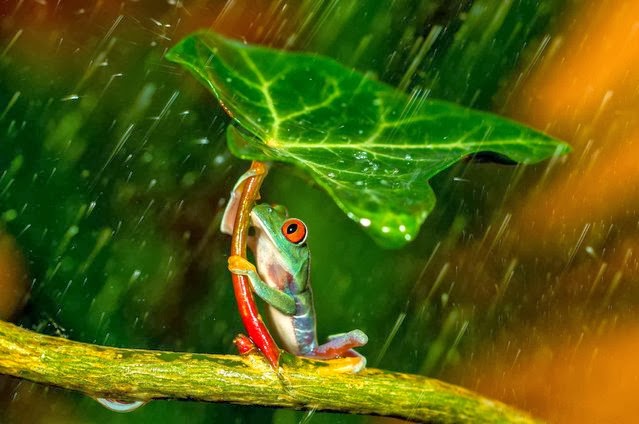Paris based photographer Olivier Grunewald has been
documenting the Kawah Ijen volcano in Indonesia, where he observed dazzling electric
blue fire can often be seen streaming down the mountain at night. Blue glow is unusual
for a volcano on the island of Java. The blue glow is actually the light from
the combustion of sulfuric gases, and some gases condense into liquid sulfur,
which continues to burn as it flows down the slopes giving the feeling of lave
flowing. I have never seen this much sulfur flowing at a volcano. Blue volcanic
fire was described in antiquity in Italy on the south slope of Mount Vesuvius
and on the island of Vulcano.Blue flames may also be observed at the base of
the plume of erupting volcanoes, when ash explosions occur. I did not use any
filters to capture his images of the blue fire. The burning happens day and
night, but it's visible only in darkness.Source: Charismatic Planet
Saturday 1 February 2014
Breathtaking Photo of Skogafoss, Iceland
Skógafoss is one of the most famous most visited waterfalls
in Iceland. Photographer Stian Klo says he had seen thousands of snaps from
this iconic waterfall and truly wanted to try to get a ‘fresh’ angle of this
breathtaking natural wonder. This is extremely beautiful waterfall, and i try
this time something different from earlier standards, and this my favorite
Icelandic adventure.
Skogafoss at Wikipedia
Stian Klo at 500px
Stunning Photographs by Amateur Photographer Kutub-Ud-din
Friday 31 January 2014
Stunning Image of Lave Lake at Mount Nyiragongo
This is truly an amazing photo of
Lava lake at Mount Nyiragongo, an active stratovolcano inside Virunga National
Park, in the Democratic Republic of the Congo. This deadly volcano has erupted
at least 34 times since 1882, forming various-sized lava lakes that have created,
drained, crater, and reformed. This beautiful snap is taken in 2011 shows the hottest
iteration of the mountain’s lava lake. It was formed of 2002 eruption. Lava
lakes are large volumes of molten lava, regularly basaltic, contained in a
volcanic vent, crater, or broad depression. The term is used to describe both
lava lakes that are wholly or partly molten and those that are solidified occasionally
referred to as frozen lava lakes.
Saturday 25 January 2014
“Cuban Trogon” World’s Most Fascinating Colorful Bird
I always believe nature is full
of amazing color, and when I see colorful birds, it’s really amazing how
beautiful our motherland is. The Cuban Trogon is one of most beautiful species
of bird belongs to Trogonidae family. It is also called Tocoror (Priotelus
Temnurus), actually endemic to the Caribbean island of Cuba. It is Cuba
national bird, and its habitats are dry forests, moist forests, and heavily
degraded former forest. It is well spread known to be Cuban Trogon, while in
Spanish it is called Tocororo or Tocoloro. The name is actually derived from
its repeated call, toco-toco-tocoro-tocoro. Its scientific name is Priotelus
temnurus which is very infrequently used in referring to this bird. The colorful
Cuban Trogon with a green back, blue crown, red belly and beak, and white
throat and chest. Interestingly these colors mimic the colors of the Cuban
flag, and that’s why it is selected to be national bird of Cuba. This bird has
a long fluffy tail, truly unique amongst trogons. The bird is between ten and
eleven inches from beak to tail. When these birds travel, they prefer in pairs
flight, creating a heavy noise because of their rough, graceless flying
technique. This is very common bird and can be seeing all over the island of
Cuba. This bird is rarely seeing on the Isle of Youth Guajaba, Romano, and
Sabinal. This bird prefers wet and dry forests of all altitudes and likes to be
in the shade as opposed to the sun. The Cuban Trogon nests in already created
crevices in trees, primarily abandoned wood pecker holes. The Cuban Trogon
feeds on flowers, fruits, and insects. Unlike most birds, it is proficient of hovering
while eating. Source: Charismatic Planet
Taj Mahal View From Western Side
This is Taj Mahal View from
Western side during the golden hour. Symbolically, the constantly changing
sunlight reflected by the mausoleum's marble has a symbolic role which
associates light with the presence of God. Located in Agra, Uttar Pradesh, the
Taj Mahal was constructed in the 17th century by Muslim King Shah Jahan and has
been called the finest example of Mughal architecture. In 1983 Taj Mahal was
designated a UNESCO World Heritage Site.
Photo: Muhammad Mahdi Karim
Subscribe to:
Posts (Atom)













































